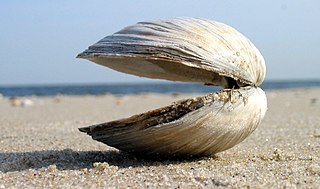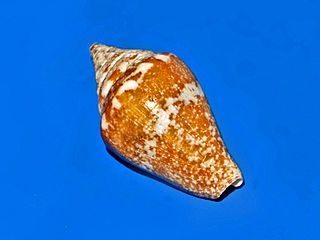Related Research Articles

Clam is a common name for several kinds of bivalve molluscs. The word is often applied only to those that are edible and live as infauna, spending most of their lives halfway buried in the sand of the seafloor. Clams have two shells of equal size connected by two adductor muscles and have a powerful burrowing foot. Clams in the culinary sense do not live attached to a substrate and do not live near the bottom. In culinary usage, clams are commonly eaten marine bivalves, as in clam digging and the resulting soup, clam chowder. Many edible clams such as palourde clams are oval or triangular; however, razor clams have an elongated parallel-sided shell, suggesting an old-fashioned straight razor.

Ruditapes philippinarum is an edible species of saltwater clam in the family Veneridae, the Venus clams.

Ruditapes is a genus of marine bivalve molluscs, in the family Veneridae.

Austrovenus stutchburyi, common name the New Zealand cockle or New Zealand little neck clam, is an edible saltwater clam, a marine bivalve mollusc in the family Veneridae, the Venus clams.

Parametaria is a genus of sea snails, marine gastropod mollusks in the family Columbellidae, the dove snails.

Phenacovolva philippinarum is a species of sea snail, a marine gastropod mollusk in the family Ovulidae, the ovulids, cowry allies or false cowries.
Eunidiini is a tribe of longhorn beetles of the subfamily Lamiinae. It was described by Téocchi et al. in 2010.
Eunidia is a genus of longhorn beetles of the subfamily Lamiinae.
Caciella philippinarum is a species of beetle in the family Cerambycidae, and the only species in the genus Caciella. It was described by Stephan von Breuning in 1936.
Eunidia fallaciosa is a species of beetle in the family Cerambycidae. It was described by Stephan von Breuning in 1939. It is known from Somalia.
Eunidia spilotoides is a species of beetle in the family Cerambycidae. It was described by Stephan von Breuning in 1939.
Eunidia subannulicornis is a species of beetle in the family Cerambycidae. It was described by Stephan von Breuning in 1968.
Eunidia annulata is a species of beetle in the family Cerambycidae. It was described by Per Olof Christopher Aurivillius in 1924.
Eunidia brunneopunctata is a species of beetle in the family Cerambycidae. It was described by Per Olof Christopher Aurivillius in 1911. It is known from South Africa, Malawi, Angola, Kenya, Ethiopia, Mozambique, Botswana, Sudan, Namibia, Senegal, the Democratic Republic of the Congo, Tanzania, Somalia, and Uganda.
Eunidia haplotrita is a species of beetle in the family Cerambycidae. It was described by Per Olof Christopher Aurivillius in 1911.
Eunidia kristenseni is a species of beetle in the family Cerambycidae. It was described by Per Olof Christopher Aurivillius in 1911. It is known from tropical Africa.
Eunidia batesi is a species of beetle in the family Cerambycidae. It was described by Olliff in 1889.
Eunidia strigata is a species of beetle in the family Cerambycidae. It was described by Fahraeus in 1872. It contains the varietas Eunidia strigata var. damarensis.

Modiolus philippinarum, common name Philippine horse mussel, is a species of "horse mussel", a marine bivalve mollusc in the family Mytilidae, the mussels.

Solecurtus is a genus of saltwater clam, a marine bivalve molluscs in the family Solecurtidae.
References
- ↑ BioLib.cz - Eunidia philippinarum. Retrieved on 8 September 2014.
| This Eunidiini article is a stub. You can help Wikipedia by expanding it. |